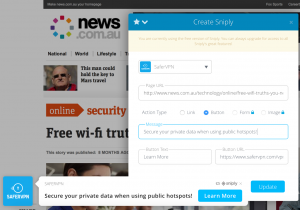
11 easy digital marketing hacks for your next PR campaign
Let’s face it, marketing any startup or small business is hard! More often than not, you’re competing against companies with much larger media and marketing budgets that have already built a steady stream of media credibility.
Whilst getting to tell your story in the media is an exciting time in the life of any business, the traffic hits you will receive to your website are hard and fast so creating strategies to leverage that traffic for a longer return on investment just makes smart business sense. Success overall can hinge upon ensuring your marketing plan is seamlessly aligned and makes the biggest impact.
But how can you do that on a shoestring budget? Below, I share my tips on growth hacking your PR efforts:
1. First things first, clean your house before inviting people over
Outside of my day job, I’m a digital marketing instructor at General Assembly and one of my first lessons to students is to ensure they clean their house (website or landing page) before inviting people over. If you are about to embark on a PR campaign (or any traffic or brand-centric campaign for that matter) it’s important to ensure your digital assets are up to task to truly represent your brand. You have this one chance to make a first impression, make sure it’s a good one!
Knowing your site is about to get an increase in traffic from your PR coverage, below are a few things you can do to get your site optimised and ready for any influx.
2. Capture Email Addresses
Consider using a popup email box as a call to action to get an email address as someone arrives at or exits your site. Try to make this compelling by giving them a discount, a free download or entry to a competition. While there have been some reports that this might affect your SEO, there are some tools such as HelloBar, which are a little less intrusive and more user-friendly.


HelloBar on ProBlogger
3. Remarketing
Have you ever visited an online store, for example to look at a pair of jeans, and then had an ad for that exact pair of jeans pop-up during your other searches? This is called remarketing (or retargeting) and is a very popular digital marketing trick to help increase conversions. To use this functionality, you need to have a retargeting pixel setup on your website, so when you have a PR hit and a sudden influx of traffic, you can later remarket to those visitors while they are browsing other websites, social media channels or even email.
4. If you link it they will come
Do all that you can to make it easy for journalists to use your business URL in their article. It’s quite rare for this to happen, but if you can pull it off, not only does it make a better user experience for the reader but it also means a higher chance of people visiting your site. Remember, the media isn’t there to promote your business; you need to provide information on your site that is valuable to their readers, for example, a report with data, or a case study that illustrates your point. Remember, not all links are created equal – if media chooses to place a link to your site, you’ll get a highly credible backlink that will help increase your SEO relevance score.
5. Leverage keyword research
Use keywords in your PR articles, research papers or opinion pieces. In no way am I saying you should disintegrate the quality of your content by packing in keywords, but judiciously using keywords your business is trying to rank for can help increase organic search results.
6. Use your PR wins as social proof to help with conversions
Having your name in the media adds a certain credibility that is hard to achieve through digital advertising or organic marketing means alone. You will notice a number of companies having a section “as seen in” or “as featured in” on their homepage to add this trust factor. If you can follow suit, don’t forget to add these trust assets to your ads, landing pages, and even your email signature – truly, just use these wins wherever they might get some visibility.

Snippet taken from Airtasker.com
7. Repurpose your content for other channels
Content takes time and money to create, and it’s a waste to only use it once. Repurpose your media content in as many different ways as you can. For example, turn a report into a creative infographic or cut a long TV segment into short snippets you can use on social channels.
8. Sharing is caring
Not only does sharing your content help you to drive more traffic and interest through to your website, but it also allows you to build more SEO friendly triggers.
- Use your PR wins as a great opportunity to share with your networks and attract potential new customers. Include a story link in your next email newsletter, post it on your blog or news section and don’t forget to share on your social channels.
- Use the power of influence. Seed your content out to bloggers and influencers who can share news about you to their networks. Try sites such as Scrunch or Buzzsumo to identify some key influencers in your field who may be interested in sharing your content, otherwise you can look to agencies such as Tribe if you want to take an influencers campaign a step further.
- Also don’t forget to share your content out on social bookmarking sites, such as Stumbleupon and Digg.
9. Redirect people back to your website with a smart URL
You’ve probably heard of Bit.ly – a program that lets you shorten your links and also keep tabs on click-throughs. Well now meet snip.ly – a close relative – which not only allows you to shorten and track your links – but also lets you add a customised CTA (call-to-action) on your content to direct people back to your website or landing page after they’ve read the PR content.

Image from snip.ly
10. Try Live Chat
With more than 42% of customers now saying they prefer live chat to telephone, live chat is carving the way for better customer experience across the web. Generally pretty easy to install, and great for driving conversations, new lead opportunities and purchase – live chat functionalities on websites gives customers an instant format to ask questions. The website Software Advice gives a good comparison of some of the more popular live chat platforms including price points and inclusions.
11. Social Media Monitoring
Use freemium monitoring tools such as Hootsuite, Sprout Social or Google Alerts to monitor any brand mentions on social media and the web. This can allow you to identify opportunities to join conversations with media or potential customers, and can also help you measure the sentiment of the campaign for future optimisation or understanding untapped opportunities.
I hope you’ve enjoyed this read. If you have any questions or hacks of your own please leave a comment below or drop me a line privately via my Contact page.
Happy optimising!
Amber









